“Well done lad”, said Wallace. “You found the cheese!”

Yesterday was a monumental day. I made cheese Gromit! All my life I have wanted to give it a go, but never made the time or found the opportunity. Since trying to live a more sustainable lifestyle, I have seized as many opportunities as I can, and willing to learn new skills where I can. This golden opportunity was too good to pass up.
The Cheese Making Workshop was held at our local community centre. The two ladies who ran the workshop were just fabulous. Dorothy and Loraine made the day a relaxed affair, and no question was too hard to answer. I could see that between them, they had years of cheese-making experience.
So, starting at the beginning, I rocked up at about 0950, after having had to turn around once because I forgot my wallet. Yes, friends, I was that excited! I was not the first to arrive, and I met most other students. They were a friendly bunch, with 3 men and 8 ladies in the class. We were asked to pick our preference of cheese recipes, and being a clever lad and having done a little research beforehand, I decided to ensure that the fruits of my labour were going to be able to be sampled within a few days. Therefore I chose to make Feta. One lady chose Wensleydale (hush Wallace), and would you believe that the majority chose Parmesan? The reason I was a bit shocked was that Feta takes 2-3 days before you can eat it, Wensleydale 1-3 months before maturity, and Parmesan 9-12 months before it matures!
All worthwhile, but if I have learnt anything on this sustainable journey, it is that if you put effort into anything, you must be able to reap the rewards quickly, which then gives you a sense of achievement that pushes you to carry on. The other thing to take into consideration is that the harder cheeses must mature at a temperature of 10-15C for the entire time. It is very hard to keep anything at that temp here in summer without a cellar or modified refrigerator.
Enough babbling, here is what I saw when I first arrived.
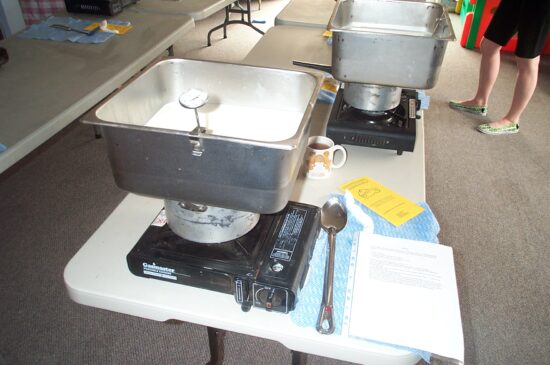
On the table are a small gas camp stove, a pot with water, and a 20-litre bain marie with 10 litres of full cream milk. The pot acted as a double boiler. Next to the spoon is a cute hair net (no photos of me wearing it either) that we had to wear so as not to get hair in the cheese.
It is illegal in Australia to make cheese out of non-pasteurised milk. Pasteurisation kills certain bacteria in the milk that can breed when the temperature of the milk is raised during the cheese-making process. To pasteurise milk, simply bring the temperature up to 68C, hold it there for 1 minute, and then cool rapidly. We were already using store-bought milk, so it was already treated. Next, we had to reverse the homogenisation process. Apparently, homogenisation shrinks the milk fat globules, which makes it nearly impossible to make into cheese. To reverse this process, we added 1 teaspoon of calcium chloride to 2 tablespoons of boiled rainwater which was then added to the milk and stirred for 25 seconds.
I then had to raise the temp of the milk to 32C and keep it there. Once at temperature, I got to add 10 grains of Mesophilic starter culture and a quarter teaspoon of lipase powder mixed with 50 ml of boiled rainwater. Here is the milk at temperature with the starter and lipase mixed in (not very exciting). You must not let the milk get over 40C or it will kill the culture.
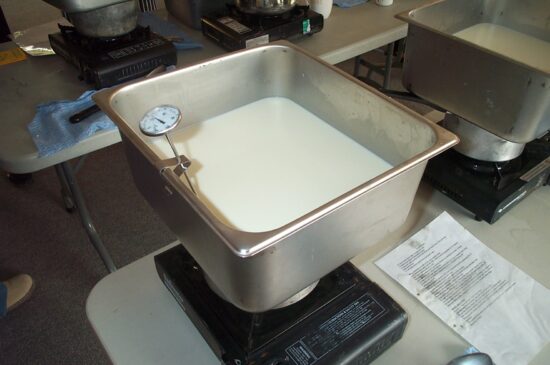
At this stage, it must ripen for 45 minutes. The starter and lipase give the cheese its distinct flavour. After the time had elapsed, the rennet is added. The temperature had to be raised again to 32C, and then 2.5ml of rennet is added to 16ml of boiled rainwater, then added to the milk with a quick stir. You cannot reheat the milk at this stage because something magical happens. The milk starts to change composition into curds and whey (Miss Muffett’s please stand). For my cheese, this process took about 40 minutes. I was told not to stir it during the setting. This is what it looks like when set. Click to enlarge and you will see where I had to put my sterilised finger in to test the firmness.
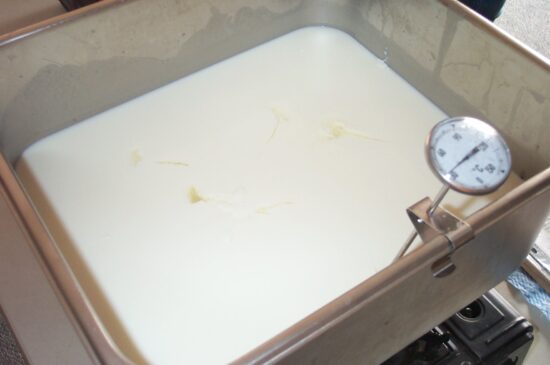
Once firm enough, I then had to cut the curd into 1 cm cubes using a whisk. Basically, you gently stab the whisk vertically into the curd until you reach the bottom. You repeat this all over the curd three times. Then you leave it to sit for 5 minutes. Here is the cut curd.
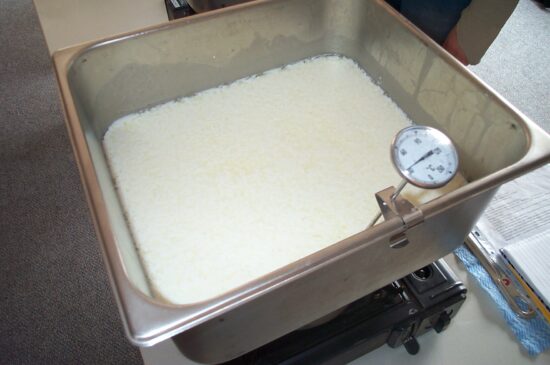
Now the boring part. You then have to stir every 10 minutes for about 2 minutes for two hours! You also have to maintain the temperature at 32C again during the process. It was during this time I decided to buy a cheese-making kit because I was determined to make more types other than Feta. The kit was $122 and from looking at other cheese-making websites, it was great value. I should be able to make at least 60kg of cheese with the kit ingredients!
This is what it looks like after the two hours. You will notice that the curds and whey have really separated and the curd sinks to the bottom.
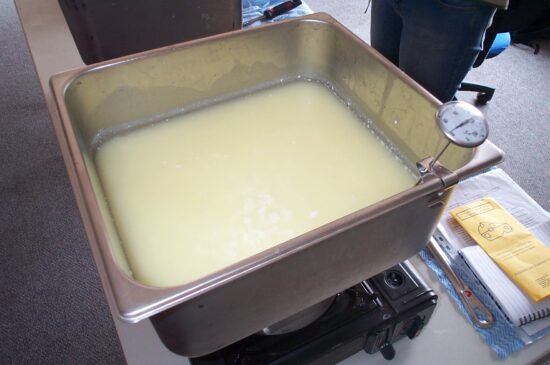
The whey looks a little yellow, doesn’t it? I bet you are thinking that this is why some cheeses are yellow. Not so my friends. The yellow in most cheeses is a food colouring. Real cheese is usually off-white!
Next, the curds are strained through a cheesecloth and the whey is kept for later on. Don’t throw the whey away (that is a mouthful), because you can make something special out of it. I will show you later. The cheese (finally) gets returned back to the bain-marie and you massage it a little until rubbery. Here is my rubbery feta.

Now it gets strained for a second time and put into the basket (mould). Luckily they had a cheese press and we could speed up the process. Here is my semi-finished cheese.

It was still a bit watery and had a little whey still oozing from it. I wrapped it in foil for the journey home.
I said goodbye to my classmates, thanked Dorothy and Loraine for a great class and told them I was coming back in three weeks for the mould cheese course. They gave me 3 litres of whey to take home.
Upon arrival at home, I placed the Feta on a wire rack to dry. It must be fairly dry before you brine the cheese. The tray is to catch any excess whey still trying to escape.
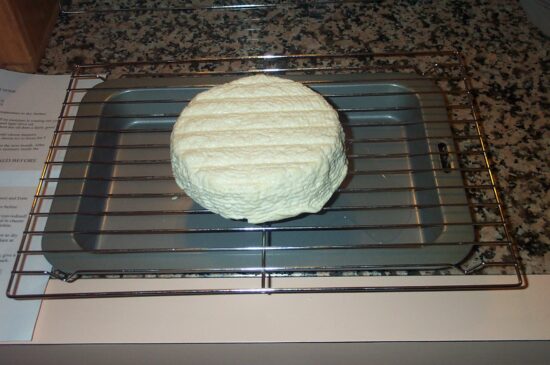
Now for the surprise! If you add a cup of milk and bring the whey to a temperature of 80-90C and hold it there for 30-50 minutes, the excess protein in the whey coagulates into Ricotta cheese! What a bonus. It tastes fantastic as well. Nice with crackers, but Kim thinks it needs a little salt to sharpen it up.
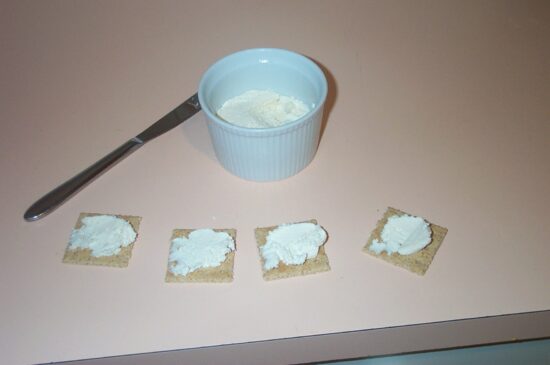
Back to the Feta. I left it on the kitchen bench overnight with a vinegar-soaked tea towel (rung out tight) covering it all. This morning it was quite dry and about 50ml of whey was in the drip tray.
I then added the Feta to the brine solution. The brine is simply 3 tablespoons of non-iodised salt to 1 litre of rainwater and bring it to a boil. Here is the photo from this morning with the Feta in the solution. The brine must be cold before adding the cheese to it, otherwise, the cheese absorbs too much salt.
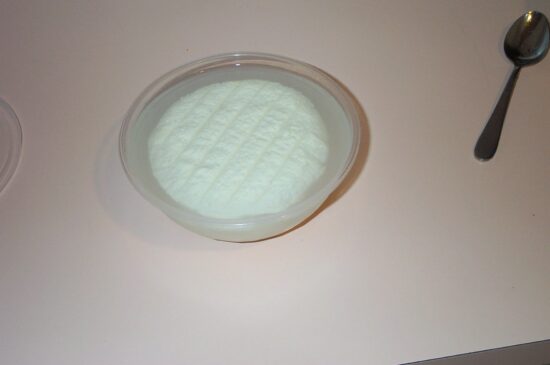
I used a food-grade plastic container, and then put it in the fridge until I got home from work. Ben met me at the door and was so excited that I was home. Not because he wanted to see his Dad safely home, but to taste Dad’s homemade cheese! And taste it we did. It was wonderful and had a firm consistency. I liken it to a texture in between the softness of a Danish Feta and the crumbliness of a Greek Feta. In the middle of the two textures and just right. It was so nice that Kim and I had some more in our homegrown garden salad for dinner. It was a great feeling that I had made or grown everything in the salad bowl!
The feta should last for a few months in the brine solution, as long as I keep it submerged. To keep it longer you can cut it into 1 cm cubes and place it in some olive oil seasoned with herbs and garlic. I am going to make another wheel of feta over the weekend and marinate the lot in oil. It takes about a week for the flavours to infuse when storing it in this method.
On Saturday, I will be making a simple cheese press from a few bits of dowel and two 20cm squares of wood. Dorothy showed us one but wanted to charge us $25 for it. I have the components in the shed, so I will have one for free!
So stay turned over the next few months as I attempt to make other cheeses. In three weeks’ time, I attend the mould cheese course and will then know how to make Brie, Camembert, Blue Vein, and Stilton. I may have trouble with these cheeses because they have to be stored at low temperatures for at least two weeks for the mould to grow. If anyone has a simple solution for the temperature issue, please share via a comment.
If you ever get the chance to do a cheese-making workshop, I can’t recommend it highly enough. It was a great day, fantastic fun and very fulfilling. All I have to find now is a local dairy that will sell me milk at wholesale prices in bulk. At least I will know where the milk comes from and how it is handled. If I can find organic, even better.
Gavin from the future here (2023)! This post was my first experience with cheesemaking and although most of the theory we learnt during the class was correct, the pressing technique certainly was not! I didn’t even know what a curd nerd was back then.
I have learnt so much since this post was written back in 2009, and I share all my experiences for free on https://cheeseman.tv, my YouTube channel with over 308,000 subscribers. Thanks for reading.

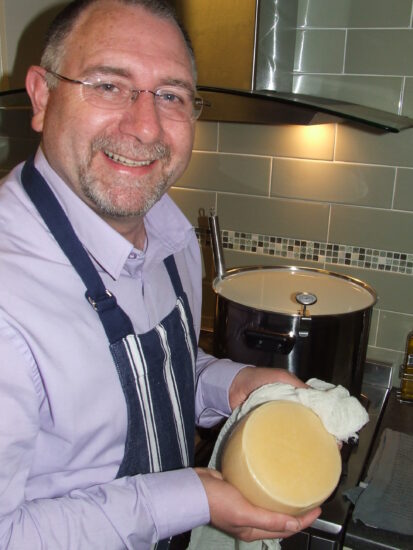
Well done Wallace,
better hide it , Speedy Gonzalas AKA Wombat and Matilda will be around to steel your cheese.
I do not have any words. That is just bloody awesum! Makes me want to go buy a cow and make my own cheese.
xoxoxox
I’m definitely envious. I wish we had workshops like that where I live. I might have to organise a visit to my friend in Melbourne to coincide with one of the workshops.
This is a great post. Thanks so much for sharing your experience!
As for storing at low temperatures, you might check craigslist or freecycle for someone giving away a minifridge. You could unplug it and store it when not in cheese use.
great blog would love to learn things like that no such luck up here where I live ELLIE
Gav, naturally Wendolene Ramsbottom wouldn’t have been at the workshop owing to cheese bringing her out in a funny rash…..
What a great day. Envious of the workshop. I too have wanted to make cheese for an age. Fancy choosing Wensleydale!!!
Lisa x
There are plans out there for a homemade cooler for making homemade beer. It consists of that tyvek type insulation board stuff, a small fan, and a compartment to put some milk jugs with frozen water. It’s economical and will keep your cheese (or beer) cool.
SorryI don’t remember the name. It’s “son of brew cooler” or something like that.
Hi Gavin,
I have really enjoyed your blog for some time now. The effort that you have put into your “cheese making experience” has been really wonderful. The documentation has been executed perfectly… but we really needed to see the hairnet in use 😉
I have learnt so much…what a powerful way for you to use your blog to educate for the common good.
Please keep up the blogging as it gives us all so many rewards.
Dear Gavin the Green,
I am working with a group of women living in a rural village in South Africa to generate some income. Our idea: goats milk products! We are going to make soap, yogurt and cheese. I can’t wait to get started. We have some similar problems as you do in Australia. Namely, HEAT. Did you ever find a storage solution for your cheese?
Great posts and information.
Way to go green.
if you have information to share my email is: meg.baldwin@gmail.com
Thanks!
Margaret,
you may be intersted in the pot in pot refrigeration concept:
http://www.communicationagents.com/chris/2004/04/14/cool_fridge_without_using_electricity.htm
basically its 2 pots, one smaller than the other. Place the small pot in the big ger pot, and fille the space with wet sand. cover with a wet cloth. the inside becomes cold via evaporation.
Hi there,
I really enjoy your cheese making adventures! Other than full cream ricotta, I am an absolute novice at cheese making. However, my cow is due to calve again any day now, and I will be in the land of milk (and honey) again. So… to this end, I bought a wine fridge from our local Aldi store for $179. Its got a digital read out that you can program from 5 degrees through to about 21 degrees. So ideal for cheeses. Mind you, I’m going to have to make a fair amount of cheese to justify the expense. I do understand that this solution may not be for you (I’d hate to imagine the carbon footprint of the fridge), but I did think I’d mention it. Perhaps you could source one through ebay?
At any rate, I’m enjoying your blog immensely! Keep up the good work.
Heidi
This is awesome! The only cheese I’ve ever tried to make is Paneer – turns out ok every time but always seem to slightly scald the milk. Your cheese making adventures make me wanna grab a kit and get stuck into it! Thanks Gavin – Love your Blog and Cheese!
Hi Casey, thanks for dropping by. Big weekend of cheese making starting tomorrow!
Gav
Looks like great experience. I will certainly try this myself.
Thanks for sharing.
Chris
http://www.sportean.com
awesome stuff! Good on you for giving it a go – can certainly see your enthusiasm 🙂
I am too worried I would stuff it up, to be honest!… also I can’t ‘do’ mouldy cheese BUT home made fetta… now THAT I could handle! 🙂
Mozarella is another that I could do with knowing how to make. I’ll keep an eye out for that popping up
Enjoy that cheese making 🙂 and thanks for sharing
Hi,
I recently made some feta, it is better than shop bought that’s for sure. I love the marinated feta, but hate the price, so guess what, I copied your idea by putting the feta cubes in olive oil, and some of my own home-grown herbs. I am just wondering do you store it in the fridge? It’s divine!!!!!!
I love cheese.
Thanks, Jo.
Hi Jo,
I find that storing in the fridge is the best idea. I once let it ripen in a cool cupboard but the cheese kept maturing and tasted rancid.
Gav x
Hi,
Thanks, I find that the olive oil becomes a bit solidified in the fridge, but I left it out before use, and it goes liquid again.
Keep up the great advice, thanks.
Jo